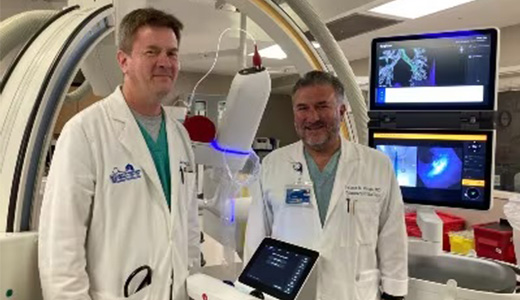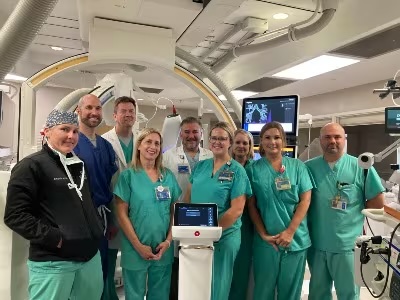New Technology at NMMC-Tupelo Expands Early Diagnosis of Lung Cancer
Innovative technology at North Mississippi Medical Center-Tupelo is helping doctors diagnose lung cancer at its earliest, most treatable stage.
- News & Media
- Press Releases
- 2023
- New Technology at NMMC-Tupelo Expands Early Diagnosis of Lung Cancer

New Technology at NMMC-Tupelo Expands Early Diagnosis of Lung Cancer
Innovative technology at North Mississippi Medical Center-Tupelo is helping doctors diagnose lung cancer at its earliest, most treatable stage.Innovative technology at North Mississippi Medical Center-Tupelo is helping doctors diagnose lung cancer at its earliest, most treatable stage.
The hospital’s new ION robotic-assisted platform allows physicians to perform minimally invasive lung biopsies and reach very small nodules that would be difficult and risky to reach with traditional biopsy methods. The robotic-assisted biopsies are significantly safer for patients.
Early detection is key to improving outcomes. Lung cancer is the leading cause of cancer deaths. However, when diagnosed at the earliest stage, the average five-year survival rate is 92%. Lung cancer screening with low dose CT provides the opportunity to identify very tiny lesions. The robotic-assisted lung biopsy makes it possible to gather tissue samples effectively and safely for a definitive diagnosis.
“That’s the beauty of it,” said pulmonologist Jaime Ungo, MD. “We can treat patients at the earliest stages when curing the disease is possible.”
Since launching the ION platform went live at NMMC-Tupelo, the medical teams have used it to perform 27 biopsies through Nov. 21.

“We are truly thrilled to be a leader in this field and look forward to continuing to bring minimally invasive robotic-assisted options to our patients,” said Domingo Valpuesta, North Mississippi Health Services vice president for pharmacy and medical imaging.
Inside out approach
For decades, health care teams have used blood vessels to navigate the body and perform minimally invasive procedures like clearing blocked arteries. The Ion robotic-assisted platform allows the medical team to move through the branching airways of the lungs to reach the small lesions for biopsy.
“We’re able to use the bronchial highway to get as close as possible to the lesions,” Dr. Ungo said. “We can navigate through smaller airways than ever before.”
The technology uses an ultrathin maneuverable tube that a physician guides through the tight turns in the lung’s airways. The platform synchronizes images from ultrasound and visual probes inside the lungs and external fluoroscopy, along with the patient’s CT scans, to guide the physician through the airways to the lesions.
Previously, needle biopsies had to go from outside the body to reach the area identified by CT scan, Dr. Ungo said. Because the procedure carried a 15-25% risk of collapsed lung (pneumothorax), the medical team had to weigh the risks to the patient against investigating small masses.
With the robotic-assisted biopsy, the team can get close to the suspicious nodule, and the risk of a collapsed lung (pneumothorax) is 0.5%.
“It’s much safer for our patients,” Dr. Ungo said.
For more information on minimally invasive biopsy at NMMC-Tupelo, visit nmhs.net.
Lung Cancer Screening
The U.S. Preventive Services Task Force recommends annual screening with low dose CT for those at high risk of developing lung cancer. The goal is to identify cancer in its earliest stages before symptoms appear. Key criteria are:
- Age 50-80 (Medicare currently covers 50-77)
- Heavy smoker or have quit within the past 15 years
- Have not had a chest CT in the past 12 months
- Willing and physically able to undergo lung cancer treatment
Lung cancer screening requires a referral from a health care provider. If you need help finding a provider, please call 1-800-THE DESK (1-800-843-3375). Visit nmhs.net/lung-cancer-screening for more information.